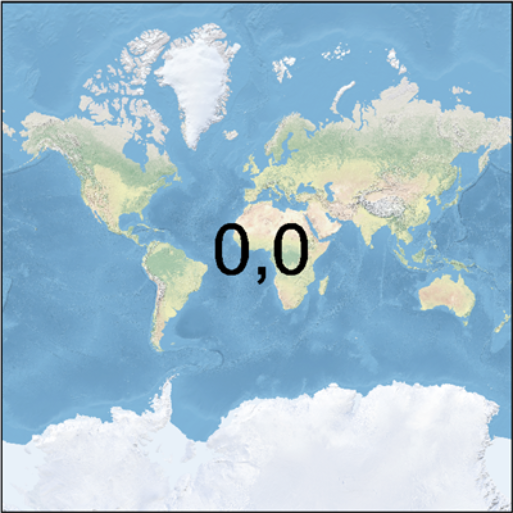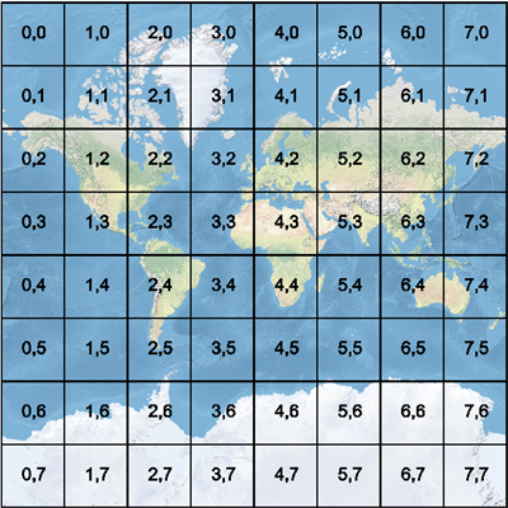Creates series of raster tiles for use in web mapping applications such as Bing™ Maps, Google Maps™, or Web Map Tile Service. Tiles are produced at varying zoom levels, size, and resolution.
Typical Uses
- Preparing raster data for use in a web mapping application
How does it work?
The WebMapTiler accepts raster features, and "pyramids" them - resampling and tiling them as necessary to produce a set of raster tiles appropriate for different zoom levels as required by various web mapping tile schemes.
The minimum and maximum zoom level may be specified, or left unset to produce the minimum and maximum level supported by the resolution and size of the input raster(s).
Tile size may be specified for some Tile Schemes. Various methods are available for interpolation of pixel values during resampling.
Attributes may be added to the output tiles to record zoom level, tile position, original raster index, number of tiles produced, and Quadkey (used for quad-tree based tile schemes).
This transformer is unaffected by raster band and/or palette selection.
Tile Schemes
Reference
|
Scheme |
Used for |
Projection* |
Tile Size |
Zoom Levels |
||||||||||||||||||||||||||||||||||||||||||||
|---|---|---|---|---|---|---|---|---|---|---|---|---|---|---|---|---|---|---|---|---|---|---|---|---|---|---|---|---|---|---|---|---|---|---|---|---|---|---|---|---|---|---|---|---|---|---|---|---|
| GoogleMapsCompatible | Google Maps, Bing Maps, Web Map Tile Service, and ArcGIS. | EPSG:3857 (Spherical Mercator) | 256x256 pixels | 0 to 23 | ||||||||||||||||||||||||||||||||||||||||||||
|
At level 0, the entire world is represented by a 256x256 pixel tile. Each level increases the number of rows and columns by a factor of two: level 1 is 512x512, level 2 is 1024x1024, and so on. The number of tiles is increased accordingly - 1 tile, 4 tiles, 16 tiles, and so on. GoogleMapsCompatible zoom level 0 tiles (column, row):
GoogleMapsCompatible zoom level 1 tiles:
GoogleMapsCompatible zoom level 3 tiles:
|
||||||||||||||||||||||||||||||||||||||||||||||||
| GoogleCRS84Quad | Web Map Tile Service | LL84 | 256x256 pixels | 0 to 18 | ||||||||||||||||||||||||||||||||||||||||||||
|
At level 0, the entire world is represented by a 256x256 pixel tile (where the first and last 64 rows of the tile are blank). Each level increases the number of rows and columns by a factor of two: level 1 is 512x512, level 2 is 1024x1024, and so on. |
||||||||||||||||||||||||||||||||||||||||||||||||
| GlobalCRS84Scale | Web Map Tile Service | LL84 | user-defined | 0 to 20 | ||||||||||||||||||||||||||||||||||||||||||||
|
Spacing is defined in degrees for each level.
|
||||||||||||||||||||||||||||||||||||||||||||||||
| GlobalCRS84Pixel | LL84 | user-defined | 0 to 17 | |||||||||||||||||||||||||||||||||||||||||||||
|
This scheme defines a spacing in degrees for each level, as follows:
|
||||||||||||||||||||||||||||||||||||||||||||||||
*Incoming rasters that are not in the required projection will be reprojected by the transformer before tiling is carried out.
In this example, we prepare a single 4800 x 4000 orthophoto of Vancouver (at 1 meter resolution) for use in Google Maps. The source image is a single GeoTIFF. Note that the projection is UTM83-10 - the transformer will need to reproject it before resampling and tiling.
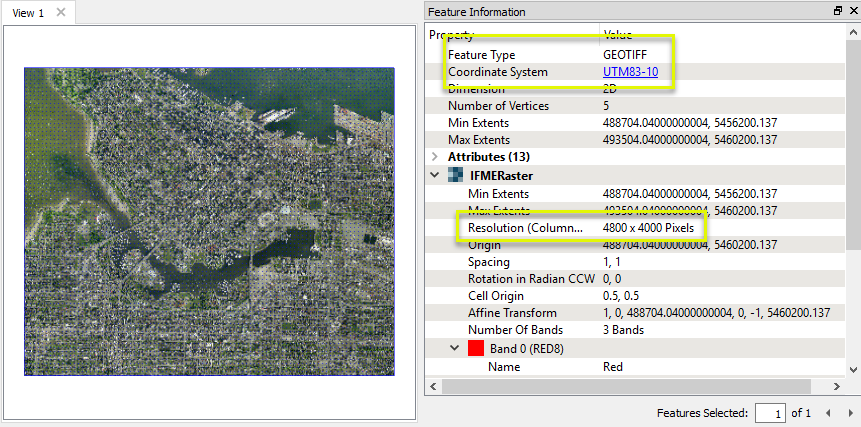
The raster is routed into a WebMapTiler.

In the parameters dialog, we choose GoogleMapsCompatible as our Tile Scheme.
Note that the Zoom Levels have been left blank. The transformer will calculate the appropriate minimum and maximum levels that can be produced from the input raster.
The zoom levels, as well as the size and position of the tiles for each level, are fixed by Google Maps. The WebMapTiler will adjust the output rasters to fit into these standards.
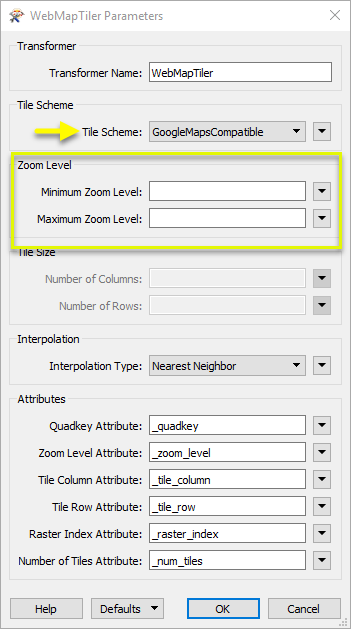
A total of 740 tiles are produced from the original. The number of tiles per zoom level can be analyzed with a StatisticsCalculator.
Note that only zoom levels 5 through 17 have been produced (out of all possible levels, from 0 - the entire earth - to 23 - the smallest possible area of coverage given the original image size and resolution).
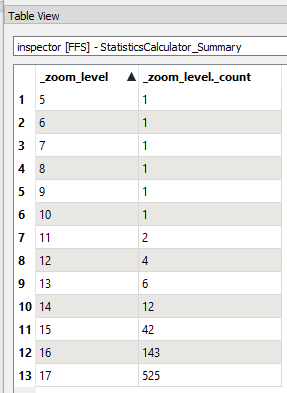
Zoom Level 10
Examining the single tile output for zoom level 10, note the new attributes added including tile position, zoom level, quadkey (used by Google Maps), and more.
The extent of the original raster falls wholly inside the extent of this standard tile’s size and position, so the raster has been padded with blank cells.
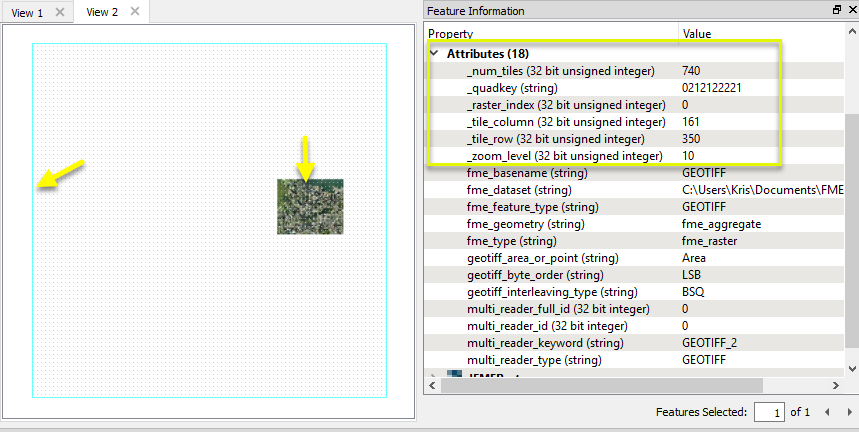
A close view of the portion of the raster containing the original shows the resampling to an appropriate (lower) resolution.
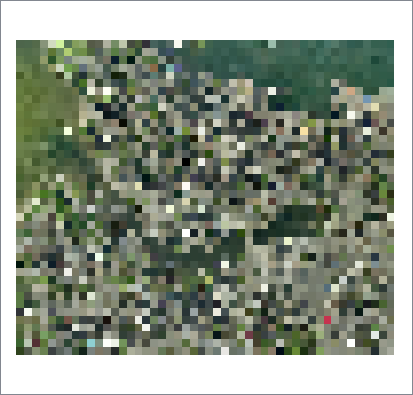
Zoom Level 15
42 tiles were produced for zoom level 15.

A closer look at the selected tile clearly shows that higher resolution is retained for higher zoom levels.
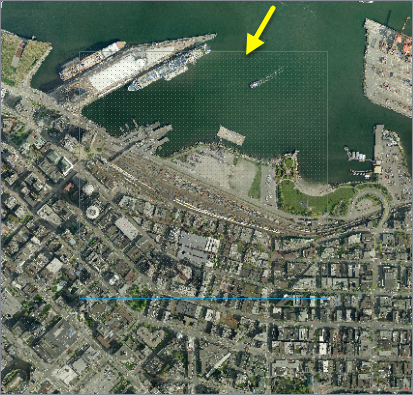
Usage Notes
-
To resample rasters using zoom levels and positions that are not tied to one of these web mapping tile schemes, consider using the RasterPyramider.
- Attributes can be used for output file naming - for example the output feature type name can be set to the Quadkey attribute value.
- Generally, when writing out the rasters generated by this transformer, one would set the destination feature type name to be the quadkey value for Bing Maps or a combination of the zoom level, tile column, and tile row for Google Maps. The PNGRASTER writer is recommended for the best results.
- For best performance, rasters output by this transformer should be written in the order they are output. Changing the order (for example, by using Dataset Fanout or a Sorter transformer) may negatively impact performance. Alternatively, use a RasterCheckpointer after the WebMapTiler, but prior to the operation that changes the order.
- When a tile contains areas outside the original raster coverage, an alpha band may be added to the tile to identify these areas. If this band is not desired, it may be removed with the RasterInterpretationCoercer transformer.
Choosing a Raster Transformer
FME has an extensive selection of transformers for working with raster data. They can be generally categorized as working with whole rasters, bands, cells or palettes, and those designed for workflow control or combing raster with vector data.
Working with Rasters
| RasterCellOriginSetter | Sets the raster's cell origin. |
| RasterConvolver |
Accepts input features containing a raster geometry and outputs the features after applying a convolution filter to all the bands. Convolution filters are applied using a kernel, specified by a matrix of weights for the neighboring values, over all the cells of an input raster geometry. Such filtering is used for smoothing, sharpening, enhancing edges and other raster image manipulation operations. |
| RasterExpressionEvaluator | Evaluates expressions on each cell in a raster, such as algebraic operations or conditional statements. |
| RasterExtentsCoercer | Replaces the geometry of input raster features with a polygon covering the extents of the raster. |
| RasterGCPExtractor | Extracts the coordinate system and the Ground Control Points (GCP) from the raster feature and exposes them as attributes. |
| RasterGCPSetter | Sets the Ground Control Points (GCP) on a raster with the specified Column (pixel), Row (line), X Coordinate, Y Coordinate and Z Coordinate. |
| RasterGeoreferencer | Georeferences a raster using the specified parameters. |
| RasterHillshader | Generates a shaded relief effect, useful for visualizing terrain. |
| RasterInterpretationCoercer |
Alters the underlying interpretation of the bands of the raster geometry on the input features, using the specified conversion options. For example, an input raster feature with three bands of interpretation (UInt16, Gray8, and Real64) could be converted to a raster feature with three bands of interpretation (Red8, Green8, and Blue8) or four bands of interpretation (Red16, Green16, Blue16, and Alpha16) in a single operation. |
| RasterMosaicker | Merges multiple raster features into a single raster feature. |
| RasterPropertyExtractor | Extracts the geometry properties of a raster feature and exposes them as attributes. |
| RasterPyramider | Creates a series of pyramid levels for each input raster feature by specifying either the smallest pyramid level size or the number of pyramid levels to generate. Pyramid levels are created by resampling input rasters to various different resolutions. |
| RasterResampler | Resamples an input raster using the desired dimensions, the desired cell size in ground units, or a percentage of the size. |
| RasterRotationApplier |
Applies the raster rotation angle on the input raster properties to the rest of the raster properties and data values. The expected input is a raster with a non-zero rotation angle and the expected output is a rotated raster with a rotation angle of 0.0. It is expected that the input raster properties will be modified to conform the output raster properties for a raster rotated by the given angle. Applying a rotation angle is primarily done for compatibility with other processing and writers that cannot handle a rotation angle. |
| RasterSubsetter | Clips raster features using pixel bounds instead of ground coordinates, and optionally adds cells around the perimeter. |
| RasterTiler | Splits each input raster into a series of tiles by specifying either a tile size in cells/pixels or the number of tiles. |
| RasterToPolygonCoercer | Creates polygons from input raster features. One polygon is output for each contiguous area of pixels with the same value in the input raster. |
| WebMapTiler | Creates a series of image tiles that can be utilized by web mapping applications such as Bing™ Maps, Google Maps™, or Web Map Tile Service. This is done by resampling rasters to various different resolutions and then splitting them into tiles. |
Working with Bands
| RasterBandAdder | Adds a new band to a raster. The added band will have the same value in all cells, and the same raster-level properties as other bands in the raster (that is, number of rows/columns, cell spacing, cell origin, and so on). |
| RasterBandCombiner | Merges multiple overlapping raster features into a single raster feature. It accepts a number of input raster features, each of which has one or more bands. The bands are removed from the input features and appended to a single output raster feature. |
| RasterBandInterpretationCoercer |
Alters the underlying interpretation of the selected bands of the raster geometry on the input features, using the specified conversion options. For example, an input raster feature with a single band of interpretation UInt8 could be converted to a single band of Gray8 or UInt16 data. |
| RasterBandKeeper |
Removes all bands of a raster, except for those that are selected. The RasterSelector can be used to modify the selection. If all bands in the source raster are selected, the raster will remain unchanged. |
| RasterBandMinMaxExtractor | Extracts the band minimum and maximum values, palette minimum and maximum keys and palette minimum and maximum values of a raster feature and exposes them as attributes. |
| RasterBandNameSetter | Sets the name of selected bands on a raster. |
| RasterBandNodataRemover | Removes the existing nodata identifier from the selected bands of a raster feature. That is, any values that were previously equal to the nodata value will now be considered valid data. |
| RasterBandNodataSetter | Identifies a value to act as a nodata identifier on a raster feature at the band level. That is, values equal to the specified value will now be considered invalid, and will not be affected by many operations (for example, offsetting or scaling). |
| RasterBandOrderer | Specifies the order of bands in a raster. Bands are reordered according to the input band indices. |
| RasterBandPropertyExtractor | Extracts the band and palette properties of a raster feature and exposes them as attributes. |
| RasterBandRemover | Removes the selected band(s) of a raster. To modify the selection, see the RasterSelector. |
| RasterBandSeparator | Separates the bands and palettes from each input raster feature into one or more output raster features based on the number of input bands and palettes. |
| RasterStatisticsCalculator | Calculates statistics on raster bands and exposes them as attributes. Bands with palettes are valid. |
Working with Cells
| RasterAspectCalculator |
Calculates the aspect (direction of slope) for each cell of a raster. Aspect is measured in degrees from 0 to 360, starting clockwise from the north. Each selected input band will be converted to a Real64 band with output values that represent the aspect. If an input band does not have a nodata value, the output band nodata value will be set to -1. |
| RasterCellCoercer | Decomposes all input numeric raster features into individual points or polygons. One vector feature is output for each cell in the band. |
| RasterCellValueCalculator | Performs an arithmetic operation on a pair of rasters. |
| RasterCellValueReplacer | Replaces a range of values in the source raster with a new single value. |
| RasterCellValueRounder | Rounds off raster cell values. |
| RasterSingularCellValueCalculator | Performs an arithmetic operation on two operands: the cell values of a raster and a numeric value. |
| RasterSlopeCalculator | Calculates the slope (maximum rate of change in z) for each cell of a raster. |
Working with Palettes
| RasterPaletteAdder |
Creates a palette from an attribute, and adds this palette to all selected bands on a raster. Selected bands are required to have an interpretation of UINT8, UINT16, or UINT32. Note that palette entries will be discarded if they do not fit within the interpretation of a selected band. For example, when adding a palette to a UINT8 band, all keys that are greater than 255 will be dropped. |
| RasterPaletteExtractor | Creates a string representation of an existing palette and saves it to an attribute. |
| RasterPaletteGenerator | Generates a palette out of the selected band(s) of a raster. The output raster will have the selected band(s) replaced by a new band with a palette. |
| RasterPaletteInterpretationCoercer |
Alters the underlying interpretation of the palettes of the raster geometry on the input features, using the specified conversion options. For example, an input raster feature with a single band with a single palette of interpretation RGB24 could be converted to a single band with a single palette of RGB64 or String data. |
| RasterPaletteNodataSetter |
Identifies the nodata value on a raster feature at the palette level. The transformer will succeed in setting the specified nodata value only if the input raster band(s) have at least one palette and a nodata key has already been set on the band. |
| RasterPaletteRemover | Removes the selected palette(s) of a raster. The palette's band retains the palette key, but the corresponding values are lost. |
| RasterPaletteResolver | Resolves the palettes of the selected bands of the input raster features by using the band cell values to look up the corresponding palette values, which then replace the original band cell values in the raster. |
Workflow Control
| RasterCheckpointer | Sets a checkpoint in the raster processing which forces previous processing to occur immediately. Once complete, it saves the current state to disk. |
| RasterConsumer | Requests the tile(s) from the raster geometry but no actual operations are performed on the tile(s). |
| RasterExtractor | Serializes the geometry of the feature into the Blob Attribute based on the selected writer format. |
| RasterNumericCreator | Creates a feature with a raster of the specified size with a numeric value and sends it into the workspace for processing. It is useful for creating a very large image with a user-specified width and height. |
| RasterReplacer | Replaces the geometry of the feature with the geometry held in the Blob Attribute. The blob is decoded according to the selected raster format. |
| RasterRGBCreator | Creates a feature with a raster of the specified size with an RGB value and sends it into the workspace for processing. |
| RasterSelector |
Selects specific bands and palettes of a raster for subsequent transformer operations. The bands and palettes are selected using the band and palette indices, specified in a string. The string may either be specified explicitly or through an attribute. The format of the string is B P (separated with a space), where B is the band index and P is the palette index of the band and palette to be operated on. Indices are zero-based, so the first band or palette is at index 0. |
Vectors and Rasters
| ImageRasterizer | Draws input point, line and polygon features onto a color raster filled with the background color. The fme_color attribute of the input vector features is used to generate pixel values. Features without an fme_color attribute will be discarded. |
| NumericRasterizer | Draws input point, line and polygon features onto a numeric raster filled with the background value. The Z coordinates of the input vector features are used to generate pixel values. Features without Z coordinates will be discarded. |
| MapnikRasterizer | Draws input point, line, polygon, and raster features onto a raster using the Mapnik toolkit. |
| PointOnRasterValueExtractor | Extracts the band and palette values from a raster at the location of each input point and sets them as attributes on the feature. |
| VectorOnRasterOverlayer | Overlays vector features onto a single raster feature by drawing them onto the resulting output raster. The properties of the output raster are identical to that of the input raster. |
Configuration
Input Ports
This transformer accepts only raster features.
Output Ports
Tiles with additional attributes, produced according to the selected Tile Scheme and other parameters.
Parameters
| Tile Scheme |
Choose a method for tiling data. Choices include:
See Tile Schemes above for more detail. |
These parameters specify the zoom levels for which tiles will be generated. Valid values vary by Tile Scheme - see Tile Schemes above for more detail.
If these values are left blank, the transformer will calculate an appropriate range of zoom levels based on the input raster.
| Minimum Zoom Level |
(Optional) Specify the minimum zoom level to be generated. If Minimum Zoom Level is unspecified, the minimum zoom level will default to the minimum level at which the raster is visible. Note that tiles will not be generated if the input raster covers less than 1 row and 1 column at a particular zoom level, regardless of the minimum zoom level value. |
| Maximum Zoom Level |
(Optional) Specify the maximum zoom level to be generated. If Maximum Zoom Level is unspecified, the maximum zoom level will be the smallest zoom level such that the resampled raster has more rows or columns than the original raster. |
These parameters specify the size of each output tile for tile schemes that support user-defined sizes.
| Number of Columns | Specify the desired tile width in cells (pixels). |
| Number of Rows | Specify the desired tile height in cells (pixels). |
| Interpolation Type |
Cell values are interpolated to produce various raster sizes and resolutions. Choose a method:
|
If attribute names are specified, new attributes are added to the output tiled rasters.
| Quadkey Attribute |
If specified, an attribute will be added to each output feature specifying the quadkey for that tile. Quadkeys are used by Bing Maps to uniquely identify a single tile at a particular level of detail. Note that this attribute will only be created for quad-tree based tile schemes (GoogleMapsCompatible and GoogleCRS84Quad). |
| Zoom Level Attribute | If specified, an attribute will be added to each output feature specifying the zoom level of that tile. |
| Tile Column Attribute | If specified, an attribute will be added to each output feature specifying the column of that tile. |
| Tile Row Attribute | If specified, an attribute will be added to each output feature specifying the row of that tile. |
| Raster Index Attribute |
If specified, an attribute will be added to each output feature that identifies which raster it was created from. This index is zero-based, so all tiles created from the first input raster will have a value of 0, all tiles created from the second input raster will have a value of 1, etc. |
| Number of Tiles Attribute | If specified, an attribute will be added to each output feature identifying the total number of tiles created from the input raster, across all zoom levels. |
Editing Transformer Parameters
Using a set of menu options, transformer parameters can be assigned by referencing other elements in the workspace. More advanced functions, such as an advanced editor and an arithmetic editor, are also available in some transformers. To access a menu of these options, click  beside the applicable parameter. For more information, see Transformer Parameter Menu Options.
beside the applicable parameter. For more information, see Transformer Parameter Menu Options.
Defining Values
There are several ways to define a value for use in a Transformer. The simplest is to simply type in a value or string, which can include functions of various types such as attribute references, math and string functions, and workspace parameters. There are a number of tools and shortcuts that can assist in constructing values, generally available from the drop-down context menu adjacent to the value field.
Using the Text Editor
The Text Editor provides a convenient way to construct text strings (including regular expressions) from various data sources, such as attributes, parameters, and constants, where the result is used directly inside a parameter.
Using the Arithmetic Editor
The Arithmetic Editor provides a convenient way to construct math expressions from various data sources, such as attributes, parameters, and feature functions, where the result is used directly inside a parameter.
Conditional Values
Set values depending on one or more test conditions that either pass or fail.
Parameter Condition Definition Dialog
Content
Expressions and strings can include a number of functions, characters, parameters, and more - whether entered directly in a parameter or constructed using one of the editors.
| These functions manipulate and format strings. | |
| A set of control characters is available in the Text Editor. | |
| Math functions are available in both editors. | |
| These operators are available in the Arithmetic Editor. | |
| These return primarily feature-specific values. | |
| FME and workspace-specific parameters may be used. | |
| Working with User Parameters | Create your own editable parameters. |
Reference
|
Processing Behavior |
|
|
Feature Holding |
No |
| Dependencies | None |
| FME Licensing Level | FME Professional Edition and above |
| Aliases | VirtualEarthTiler |
| History | This transformer was previously named the VirtualEarthTiler. |
| Categories |
FME Knowledge Center
The FME Knowledge Center is the place for demos, how-tos, articles, FAQs, and more. Get answers to your questions, learn from other users, and suggest, vote, and comment on new features.
Search for all results about the WebMapTiler on the FME Knowledge Center.
Examples may contain information licensed under the Open Government Licence – Vancouver
